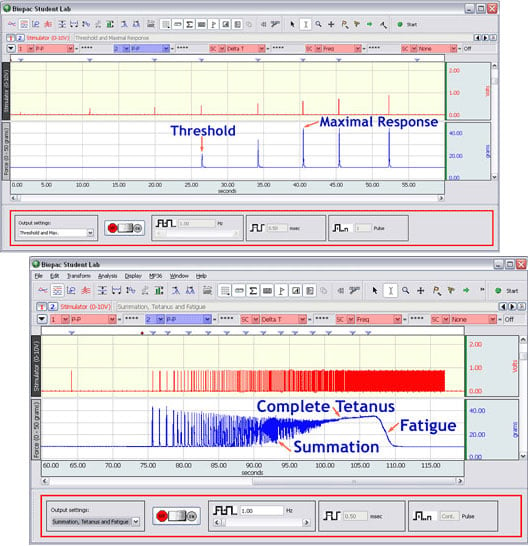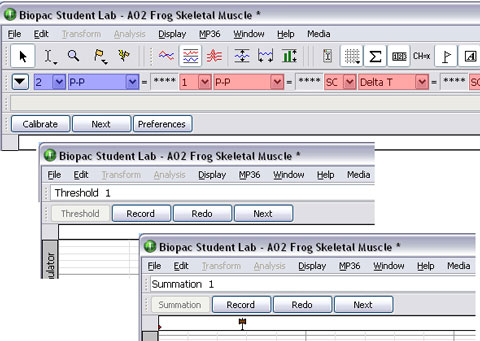A02 Frog Gastrocnemius

This BSL PRO Lesson explains how to isolate the gastrocnemius muscle of the frog and its somatic motor nerve (the sciatic nerve) and describes the hardware and software setup necessary to record threshold voltage and contractile responses.
- BSL 4.0.1 and above: expanded lesson with comprehensive introductory text and updated template

Experimental Objectives
- To record the twitch threshold, maximal twitch response, summation, tetanus and fatigue for frog skeletal muscle and its motor nerve.
- * Examine the effects of the length of the sarcomere on the force of contraction.
- * Observe how the pH of the muscle changes as it becomes fatigued.
* These objectives are covered in the introductory text and recording template for BSL 4.0.1 or above only.
Tasks Performed by the Student
Isolate the gastrocnemius muscle and stimulate to observe and measure threshold and maximal response, and summation, tetanus, and fatigue.
NOTE
- The software automates the calibration procedure for the student—no knobs and dials to confuse the student.
- The MP36 gtl settings use an acquisition rate of 2,000 samples per second in order to visualize the 0.5 msec. pulse width and SCALE Value 2 (voltage setting for the stimulator) is 10 Volts.
- -IT and -RU translations use BSL 3.6.6-4.00 with older lesson and template
Videos
Biopac Student Lab Student Download
Student Prep & Distance Learning
Click the link(s) below for sample data and/or lesson procedure video(s), BSL PRO Lesson procedures (PDF) for human lessons*, and graph template files (*.gtl) for BSL PRO Lessons. If more than one .gtl is available, download the .gtl with the _suffix to match BSL version and hardware.
Lesson Hardware
This lesson requires a Biopac Student Lab (BSL) System and the following hardware. If your BSL System does not include all hardware items, expand your system by selecting required items below. For more details, review the Lesson: L# BSL Lessons - see the Lab Manual or launch BSL; A# and H# BSL PRO Lessons, click the PDF link above to review full setup, recording, and analysis procedures.
Stay Connected